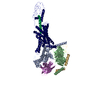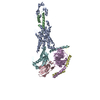[English] 日本語
 Yorodumi
Yorodumi- PDB-6lpb: Cryo-EM structure of the human PAC1 receptor coupled to an engine... -
+ Open data
Open data
- Basic information
Basic information
| Entry | Database: PDB / ID: 6lpb | ||||||
|---|---|---|---|---|---|---|---|
| Title | Cryo-EM structure of the human PAC1 receptor coupled to an engineered heterotrimeric G protein | ||||||
 Components Components |
| ||||||
 Keywords Keywords | SIGNALING PROTEIN/HORMONE / CLASS B GPCR / PACAP / PAC1R / SIGNALING PROTEIN-HORMONE COMPLEX | ||||||
| Function / homology |  Function and homology information Function and homology informationnegative regulation of response to reactive oxygen species / development of primary female sexual characteristics / pituitary adenylate cyclase activating polypeptide activity / vasoactive intestinal polypeptide receptor activity / positive regulation of chemokine (C-C motif) ligand 5 production / positive regulation of growth hormone secretion / positive regulation of cAMP-mediated signaling / NGF-independant TRKA activation / regulation of G protein-coupled receptor signaling pathway / neuropeptide hormone activity ...negative regulation of response to reactive oxygen species / development of primary female sexual characteristics / pituitary adenylate cyclase activating polypeptide activity / vasoactive intestinal polypeptide receptor activity / positive regulation of chemokine (C-C motif) ligand 5 production / positive regulation of growth hormone secretion / positive regulation of cAMP-mediated signaling / NGF-independant TRKA activation / regulation of G protein-coupled receptor signaling pathway / neuropeptide hormone activity / G-protein activation / Activation of the phototransduction cascade / Glucagon-type ligand receptors / Thromboxane signalling through TP receptor / Sensory perception of sweet, bitter, and umami (glutamate) taste / G beta:gamma signalling through PI3Kgamma / G beta:gamma signalling through CDC42 / Ca2+ pathway / Cooperation of PDCL (PhLP1) and TRiC/CCT in G-protein beta folding / G protein-coupled peptide receptor activity / Activation of G protein gated Potassium channels / Inhibition of voltage gated Ca2+ channels via Gbeta/gamma subunits / G alpha (z) signalling events / Vasopressin regulates renal water homeostasis via Aquaporins / Glucagon-like Peptide-1 (GLP1) regulates insulin secretion / positive regulation of small GTPase mediated signal transduction / neuropeptide binding / Adrenaline,noradrenaline inhibits insulin secretion / ADP signalling through P2Y purinoceptor 12 / G alpha (q) signalling events / insulin secretion / Thrombin signalling through proteinase activated receptors (PARs) / G alpha (i) signalling events / Activation of G protein gated Potassium channels / G-protein activation / G beta:gamma signalling through PI3Kgamma / Prostacyclin signalling through prostacyclin receptor / G beta:gamma signalling through PLC beta / ADP signalling through P2Y purinoceptor 1 / Thromboxane signalling through TP receptor / Presynaptic function of Kainate receptors / G beta:gamma signalling through CDC42 / Inhibition of voltage gated Ca2+ channels via Gbeta/gamma subunits / Glucagon-type ligand receptors / G alpha (12/13) signalling events / G beta:gamma signalling through BTK / ADP signalling through P2Y purinoceptor 12 / Adrenaline,noradrenaline inhibits insulin secretion / alkylglycerophosphoethanolamine phosphodiesterase activity / Cooperation of PDCL (PhLP1) and TRiC/CCT in G-protein beta folding / Thrombin signalling through proteinase activated receptors (PARs) / Ca2+ pathway / Extra-nuclear estrogen signaling / G alpha (z) signalling events / G alpha (s) signalling events / G alpha (q) signalling events / positive regulation of inositol phosphate biosynthetic process / positive regulation of calcium ion transport into cytosol / photoreceptor outer segment membrane / peptide hormone receptor binding / G alpha (i) signalling events / Glucagon-like Peptide-1 (GLP1) regulates insulin secretion / activation of adenylate cyclase activity / spectrin binding / Vasopressin regulates renal water homeostasis via Aquaporins / peptide hormone binding / adenylate cyclase binding / negative regulation of cell cycle / bicellular tight junction / photoreceptor outer segment / neuropeptide signaling pathway / positive regulation of protein kinase activity / multicellular organismal response to stress / cardiac muscle cell apoptotic process / cAMP-mediated signaling / photoreceptor inner segment / positive regulation of GTPase activity / female pregnancy / adenylate cyclase-activating G protein-coupled receptor signaling pathway / adenylate cyclase-modulating G protein-coupled receptor signaling pathway / caveola / small GTPase binding / Glucagon-type ligand receptors / cellular response to catecholamine stimulus / sensory perception of taste / adenylate cyclase-activating dopamine receptor signaling pathway / cellular response to prostaglandin E stimulus / G-protein beta-subunit binding / heterotrimeric G-protein complex / neuron projection development / positive regulation of cold-induced thermogenesis / signaling receptor complex adaptor activity / cell-cell signaling / GTPase binding / response to estradiol / regulation of protein localization / retina development in camera-type eye / signaling receptor activity / phospholipase C-activating G protein-coupled receptor signaling pathway / positive regulation of cytosolic calcium ion concentration Similarity search - Function | ||||||
| Biological species |  Homo sapiens (human) Homo sapiens (human) unidentified (others)  | ||||||
| Method | ELECTRON MICROSCOPY / single particle reconstruction / cryo EM / Resolution: 3.9 Å | ||||||
 Authors Authors | Kobayashi, K. / Shihoya, W. / Nishizawa, T. / Nureki, O. | ||||||
 Citation Citation |  Journal: Nat Struct Mol Biol / Year: 2020 Journal: Nat Struct Mol Biol / Year: 2020Title: Cryo-EM structure of the human PAC1 receptor coupled to an engineered heterotrimeric G protein. Authors: Kazuhiro Kobayashi / Wataru Shihoya / Tomohiro Nishizawa / Francois Marie Ngako Kadji / Junken Aoki / Asuka Inoue / Osamu Nureki /  Abstract: Pituitary adenylate cyclase-activating polypeptide (PACAP) is a pleiotropic neuropeptide hormone. The PACAP receptor PAC1R, which belongs to the class B G-protein-coupled receptors (GPCRs), is a drug ...Pituitary adenylate cyclase-activating polypeptide (PACAP) is a pleiotropic neuropeptide hormone. The PACAP receptor PAC1R, which belongs to the class B G-protein-coupled receptors (GPCRs), is a drug target for mental disorders and dry eye syndrome. Here, we present a cryo-EM structure of human PAC1R bound to PACAP and an engineered G heterotrimer. The structure revealed that transmembrane helix TM1 plays an essential role in PACAP recognition. The extracellular domain (ECD) of PAC1R tilts by ~40° compared with that of the glucagon-like peptide-1 receptor (GLP-1R) and thus does not cover the peptide ligand. A functional analysis demonstrated that the PAC1R ECD functions as an affinity trap and is not required for receptor activation, whereas the GLP-1R ECD plays an indispensable role in receptor activation, illuminating the functional diversity of the ECDs in class B GPCRs. Our structural information will facilitate the design and improvement of better PAC1R agonists for clinical applications. | ||||||
| History |
|
- Structure visualization
Structure visualization
| Movie |
 Movie viewer Movie viewer |
|---|---|
| Structure viewer | Molecule:  Molmil Molmil Jmol/JSmol Jmol/JSmol |
- Downloads & links
Downloads & links
- Download
Download
| PDBx/mmCIF format |  6lpb.cif.gz 6lpb.cif.gz | 210.7 KB | Display |  PDBx/mmCIF format PDBx/mmCIF format |
|---|---|---|---|---|
| PDB format |  pdb6lpb.ent.gz pdb6lpb.ent.gz | 163.3 KB | Display |  PDB format PDB format |
| PDBx/mmJSON format |  6lpb.json.gz 6lpb.json.gz | Tree view |  PDBx/mmJSON format PDBx/mmJSON format | |
| Others |  Other downloads Other downloads |
-Validation report
| Summary document |  6lpb_validation.pdf.gz 6lpb_validation.pdf.gz | 1.1 MB | Display |  wwPDB validaton report wwPDB validaton report |
|---|---|---|---|---|
| Full document |  6lpb_full_validation.pdf.gz 6lpb_full_validation.pdf.gz | 1.1 MB | Display | |
| Data in XML |  6lpb_validation.xml.gz 6lpb_validation.xml.gz | 40.2 KB | Display | |
| Data in CIF |  6lpb_validation.cif.gz 6lpb_validation.cif.gz | 62 KB | Display | |
| Arichive directory |  https://data.pdbj.org/pub/pdb/validation_reports/lp/6lpb https://data.pdbj.org/pub/pdb/validation_reports/lp/6lpb ftp://data.pdbj.org/pub/pdb/validation_reports/lp/6lpb ftp://data.pdbj.org/pub/pdb/validation_reports/lp/6lpb | HTTPS FTP |
-Related structure data
| Related structure data |  0940MC M: map data used to model this data C: citing same article ( |
|---|---|
| Similar structure data | |
| EM raw data |  EMPIAR-10351 (Title: Cryo-EM structure of the human PAC1 receptor coupled to an engineered heterotrimeric G protein EMPIAR-10351 (Title: Cryo-EM structure of the human PAC1 receptor coupled to an engineered heterotrimeric G proteinData size: 3.5 TB Data #1: Unaligned movies for the human PAC1 receptor coupled to Gs (dimer) [micrographs - multiframe]) |
- Links
Links
- Assembly
Assembly
| Deposited unit | 
| ||||||||||||
|---|---|---|---|---|---|---|---|---|---|---|---|---|---|
| 1 |
| ||||||||||||
| Symmetry | Point symmetry: (Schoenflies symbol: C2 (2 fold cyclic)) | ||||||||||||
| Noncrystallographic symmetry (NCS) | NCS oper:
|
- Components
Components
-Pituitary adenylate cyclase-activating ... , 2 types, 2 molecules PR
| #1: Protein/peptide | Mass: 4547.336 Da / Num. of mol.: 1 / Source method: obtained synthetically / Source: (synth.)  Homo sapiens (human) / References: UniProt: P18509 Homo sapiens (human) / References: UniProt: P18509 |
|---|---|
| #2: Protein | Mass: 46675.520 Da / Num. of mol.: 1 Source method: isolated from a genetically manipulated source Source: (gene. exp.)  Homo sapiens (human) / Gene: ADCYAP1R1 / Production host: Homo sapiens (human) / Gene: ADCYAP1R1 / Production host:  Homo sapiens (human) / References: UniProt: P41586 Homo sapiens (human) / References: UniProt: P41586 |
-Guanine nucleotide-binding protein ... , 3 types, 3 molecules BAG
| #3: Protein | Mass: 38744.371 Da / Num. of mol.: 1 Source method: isolated from a genetically manipulated source Source: (gene. exp.)   |
|---|---|
| #4: Protein | Mass: 28964.734 Da / Num. of mol.: 1 Source method: isolated from a genetically manipulated source Source: (gene. exp.)  Homo sapiens (human) / Production host: Homo sapiens (human) / Production host:  |
| #6: Protein | Mass: 7547.685 Da / Num. of mol.: 1 Source method: isolated from a genetically manipulated source Source: (gene. exp.)   |
-Antibody , 1 types, 1 molecules N
| #5: Antibody | Mass: 15015.728 Da / Num. of mol.: 1 Source method: isolated from a genetically manipulated source Source: (gene. exp.) unidentified (others) / Production host:  |
|---|
-Details
| Has protein modification | Y |
|---|
-Experimental details
-Experiment
| Experiment | Method: ELECTRON MICROSCOPY |
|---|---|
| EM experiment | Aggregation state: PARTICLE / 3D reconstruction method: single particle reconstruction |
- Sample preparation
Sample preparation
| Component | Name: PAC1R-Gs trimer / Type: COMPLEX / Entity ID: all / Source: RECOMBINANT |
|---|---|
| Molecular weight | Experimental value: NO |
| Source (natural) | Organism:  Homo sapiens (human) Homo sapiens (human) |
| Source (recombinant) | Organism:  Homo sapiens (human) Homo sapiens (human) |
| Buffer solution | pH: 7.4 |
| Specimen | Embedding applied: NO / Shadowing applied: NO / Staining applied: NO / Vitrification applied: YES |
| Specimen support | Grid material: COPPER/RHODIUM / Grid mesh size: 300 divisions/in. / Grid type: Quantifoil R1.2/1.3 |
| Vitrification | Instrument: FEI VITROBOT MARK IV / Cryogen name: ETHANE / Humidity: 100 % / Chamber temperature: 277 K |
- Electron microscopy imaging
Electron microscopy imaging
| Experimental equipment |  Model: Titan Krios / Image courtesy: FEI Company |
|---|---|
| Microscopy | Model: FEI TITAN KRIOS |
| Electron gun | Electron source:  FIELD EMISSION GUN / Accelerating voltage: 300 kV / Illumination mode: OTHER FIELD EMISSION GUN / Accelerating voltage: 300 kV / Illumination mode: OTHER |
| Electron lens | Mode: BRIGHT FIELD |
| Image recording | Electron dose: 64 e/Å2 / Film or detector model: FEI FALCON III (4k x 4k) |
- Processing
Processing
| Software | Name: PHENIX / Version: 1.14_3260: / Classification: refinement |
|---|---|
| EM software | Name: PHENIX / Version: 1.14 / Category: model refinement / Details: phenix.real_space_refine |
| CTF correction | Type: PHASE FLIPPING AND AMPLITUDE CORRECTION |
| Symmetry | Point symmetry: C2 (2 fold cyclic) |
| 3D reconstruction | Resolution: 3.9 Å / Resolution method: FSC 0.143 CUT-OFF / Num. of particles: 132808 / Symmetry type: POINT |
| Atomic model building | Protocol: OTHER |
| Atomic model building | PDB-ID: 5VAI Accession code: 5VAI / Source name: PDB / Type: experimental model |
 Movie
Movie Controller
Controller












 PDBj
PDBj
















